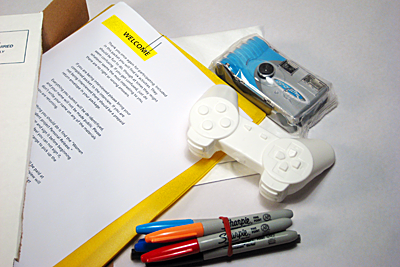Project and
Methods:
Probes:
Overview:
Cultural probes, Residential probes, Activity packs
note: in this paper "cultural probes" always refer to work done by Gaver's team while "probes" refers more broadly to work done with a similar structure. Also, "activity pack" is an alternative to "probe pack," "probe package," or "probes." It was first used by the designers on the Blux team. They found "probes" too cold of an internal design term when working with six-year-old boys. By calling them activities, the designer's and the user's engagement is highlighted. While, probes connotes a passive audience that is being probed by an active designer. Here "activities," and "probes" are used interchangeably.
Along with interviews, the use of probes was the primary means of gathering responses from the participants in Women Who Play. The first set of probes was developed by a team at the RCA for the Equator project (Boehner, pg 1; Hemmings, pg 1). A team led by Bill Gaver developed "Cultural Probes" as "collections of evocative tasks meant to elicit inspirational responses from people--not comprehensive information about them, but fragmentary clues about their lives and thoughts" (W. Gaver et.al. 2004, pg 1).
The Digital Care project was an early adopter of probes. The ethnographer on their team created Residential Probes as a way of soliciting information--not inspiration--from sensitive groups where other ethnographic means would not be possible (Hemmings, pg 2). Their use of a probe technique for information would quickly become the dominate way the probes where taken up into practice (W. Gaver, 2004 pg 1; Boehner, pg 1).
Within the Super Studio context probes were added to the research process beginning with Mobo. Super Studio has constructed its own ways of deploying and using probes that encompasses both clarity and ambiguity. "Throughout the research process, we embrace both clarity and ambiguity, as we analyze, interpret and reconfigure probes to create a rich context for design that speaks authentically to the populations being researched" (L Nugent et.al. 2007, pg 2).
 The Women Who Play probe kit.
The Women Who Play probe kit."In many instances, researchers adopt cultural probes as a kind of ready-made kit with minimal adaptation except for the directions, including in it a camera with tasks, postcards with evocative (or semi-evocative) prompts, and maps for depicting activities or relationships."--Boehner et. al. How HCI Interprets the Probes, pg 1079.
Women Who Play did not intend to use previous cultural probes as ready made answers. In a first round of sketches over 50 ideas were produced, with a dozen or more new ideas formulated in the second round. The final selection of six probes (many of which combinations of previous ideas) do share a similarity with the original cultural probes. There is a camera with tasks, cards with evocative images, and a map for charting relationships, among other probes. The similarities can be accounted for in two ways; the designer and advisors choosing the probes were familiar with the original cultural probes, and there are only so many ways to construct these activities.
Below are specific descriptions of probes, why certain design decisions were made, and reflection on those decisions.